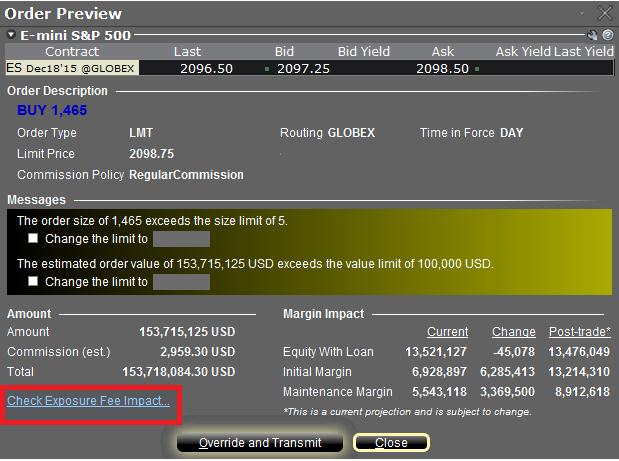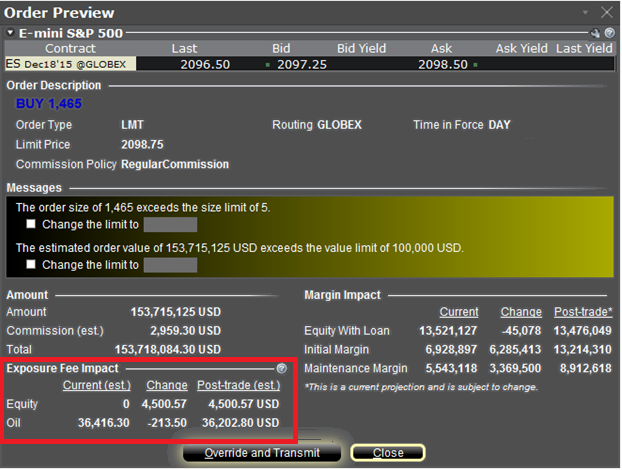Überblick über Marginmethodik
Einleitung
Weitere Informationsquellen
Instrumente zur Verwaltung und Nachverfolgung von Margins
Wie Sie feststellen können, ob Sie sich Geld von IBKR ausleihen
Ordervorschau - Auswirkungen auf Risikogebühren überprüfen
IB stellt Ihnen eine Funktion zur Verfügung, mit der Kontoinhaber überprüfen können, ob und in welchem Maße sich eine Order auf die voraussichtlichen Risikogebühren auswirken würde. Diese Funktion sollte vor der Übermittlung einer Order verwendet werden, damit Sie bereits vorab über die resultierenden Gebühren informiert sind. So haben Sie die Möglichkeit, Änderungen an der Order vorzunehmen, noch bevor Sie diese übermitteln, um ggf. die anfallenden Gebühren zu verringern oder zu aufzuheben.
Sie können diese Funktion aktivieren, indem Sie mit der rechten Maustaste die Orderzeile anklicken. Daraufhin öffnet sich die Ordervorschau. Dieses Fenster enthält einen Link mit der Bezeichnung „Auswirkungen auf Risikogebühren prüfen“ (s. rote Markierung in Abbildung I).
Abbildung I

Wenn Sie diesen Link anklicken, wird das Fenster erweitert. Sie sehen nun eine Übersicht über ggf. anfallende Risikogebühren für die aktuellen Positionen, sowie die Veränderung der Gebühr bei Ausführung der angezeigten Order und die Gesamtgebührensumme nach Ausführung der Order (s. rote Markierung in Abbildung II unten). Diese Beträge werden weiter in die jeweiligen Produktklassen aufgeschlüsselt, für die die Gebühren anfallen (z. B. Aktien, Öl). Kontoinhaber können dieses Fenster einfach schließen, ohne die Order zu übermitteln, falls die Auswirkungen auf die Risikogebühren sich als zu groß erweisen.
Abbildung II

In Artikel KB2275 erhalten Sie Informationen zur Verwendung des RiskNavigator von IB für die Verwaltung und Vorabberechnung von Risikogebühren. Informationen zur Kontrolle der Gebühren über das Kontoübersichtsfenster erhalten Sie in Artikel KB2344.
Nutzung des RiskNavigator zur Vorausberechnung von Risikogebühren
Der RiskNavigator von IB enthält eine spezielle Szenario-Funktion, mit deren Hilfe ermittelt werden kann, ob und in welchem Maße sich eine Veränderung in einem Portfolio auf die Höhe der Risikogebühr auswirken würde. Im Folgenden werden die Schritte zur Erstellung eines „Was-wäre-wenn“-Portfolios erläutert, entweder auf Basis angenommener Veränderungen in einem bestehenden Portfolio oder auf Basis eines gänzlich neu entworfenen Portfolios, einschließlich Berechnung der resultierenden Risikogebühren. Bitte beachten Sie, dass diese Funktion in der TWS Version 951 und höher verfügbar sind.
.jpg)
.png)
.jpg)
.jpg)
.jpg)
.jpg)
Abbildung 7
.jpg)
.jpg)
Informationen dazu, wie Sie die Risikogebühr über das Kontoübersichtsfenster kontrollieren können, erhalten Sie in Artikel KB2344. Informationen zur Verifizierung der Risikogebühr über das Ordervorschau-Fenster finden Sie in Artikel KB2276.
Order Preview - Check Exposure Fee Impact
IB provides a feature which allows account holders to check what impact, if any, an order will have upon the projected Exposure Fee. The feature is intended to be used prior to submitting the order to provide advance notice as to the fee and allow for changes to be made to the order prior to submission in order to minimize or eliminate the fee.
The feature is enabled by right-clicking on the order line at which point the Order Preview window will open. This window will contain a link titled "Check Exposure Fee Impact" (see red highlighted box in Exhibit I below).
Exhibit I

Clicking the link will expand the window and display the Exposure fee, if any, associated with the current positions, the change in the fee were the order to be executed, and the total resultant fee upon order execution (see red highlighted box in Exhibit II below). These balances are further broken down by the product classification to which the fee applies (e.g. Equity, Oil). Account holders may simply close the window without transmitting the order if the fee impact is determined to be excessive.
Exhibit II

Please see KB2275 for information regarding the use of IB's Risk Navigator for managing and projecting the Exposure Fee and KB2344 for monitoring fees through the Account Window
Important Notes
1. The Estimated Next Exposure Fee is a projection based upon readily available information. As the fee calculation is based upon information (e.g., prices and implied volatility factors) available only after the close, the actual fee may differ from that of the projection.
2. The Check Exposure Fee Impact is only available for accounts that have been charged an exposure fee in the last 30 days
Using Risk Navigator to Project Exposure Fees
IB's Risk Navigator provides a custom scenario feature which allows one to determine what effect, if any, changes to their portfolio will have to the Exposure fee. Outlined below are the steps for creating a “what-if” portfolio through assumed changes to an existing portfolio or through an entirely new proposed portfolio along with determining the resultant fee. Note that this feature is available through TWS build 971.0i and above.
.png)
.png)
.png)
.png)
.png)
.png)
.png)
Please see KB2344 for information on monitoring the Exposure fee through the Account Window and KB2276 for verifying exposure fee through the Order Preview screen.
Important Note
1. The on-demand Exposure Fee check represents a projection based upon readily available information. As the fee calculation is based upon information (e.g., prices and implied volatility factors) available only after the close, the actual fee may differ from that of the projection.
Overview of Margin Methodologies
Introduction
Where to Learn More
Tools provided to monitor and manage margin
How to determine if you are borrowing funds from IBKR
Why does IBKR calculate and report a margin requirement when I am not borrowing funds?
Margin Requirement on Leveraged ETF Products
Leveraged Exchange Traded Funds (ETFs) are a subset of general ETFs and are intended to generate performance in multiples of that of the underlying index or benchmark (e.g. 200%, 300% or greater). In addition, some of these ETFs seek to generate performance which is not only a multiple of, but also the inverse of the underlying index or benchmark (e.g., a short ETF). To accomplish this, these leveraged funds typically include among their holdings derivative instruments such as options, futures or swaps which are intended to provide the desired leverage and/or inverse performance.
Exchange margin rules seek to recognize the additional leverage and risk associated with these instruments by establishing a margin rate which is commensurate with that level of leverage (but not to exceed 100% of the ETF value). Thus, for example, whereas the base strategy-based maintenance margin requirement for a non-leveraged long ETF is set at 25% and a short non-leveraged ETF at 30%, examples of the maintenance margin change for leveraged ETFs are as follows:
1. Long an ETF having a 200% leverage factor: 50% (= 2 x 25%)
2. Short an ETF having a 300% leverage factor: 90% (= 3 x 30%)
A similar scaling in margin is also in effect for options. For example, the Reg. T maintenance margin requirement for a non-leveraged, short broad based ETF index option is 100% of the option premium plus 15% of the ETF market value, less any out-of-the-money amount (to a minimum of 10% of ETF market value in the case of calls and 10% of the option strike price in the case of puts). In the case where the option underlying is a leveraged ETF, however, the 15% rate is increased by the leverage factor of the ETF.
In the case of portfolio margin accounts, the effect is similar, with the scan ranges by which the leveraged ETF positions are stress tested increasing by the ETF leverage factor. See NASD Rule 2520 and NYSE Rule 431 for further details.
What happens if the net liquidating equity in my Portfolio Margining account falls below USD 100,000?
Portfolio Margining accounts reporting net liquidating equity below USD 100,000 are limited to entering trades which serve solely to reduce the margin requirement until such time as either: 1) the equity increases to above 100,000 or 2) the account holder requests a downgrade to Reg T style margining through Client Portal (select the Settings, Account Settings, Configure and Account Type menu options).
If a Portfolio Margining eligible account reporting net liquidating equity below USD 100,000 enters an order which, if executed, would serve to increase the margin requirement, the following TWS message will be displayed: "Your order is not accepted, margin requirement increase not allowed. Equity with loan value is less than 100,000.00 USD."
IMPORTANT NOTICE
Please note that requests to downgrade to Reg. T will become effective the following business day if submitted prior to 4:00 ET. Also note that as the Reg. T margining methodology generally affords less leverage than does Portfolio Margining, requesting a downgrade may lead to the automatic liquidation of positions in your account in order to comply with Reg. T. You will receive a warning message if that is the case at the time you request the downgrade.
-->
What positions are eligible for Portfolio Margining?
Portfolio Margining is eligible for US securities positions including stocks, ETFs, stock and index options and single stock futures. It does not apply to US futures or futures options positions or non-US stocks, which may already be margined using an exchange approved risk based margining methodology.
